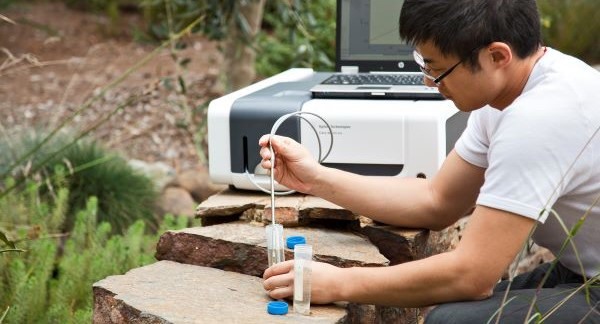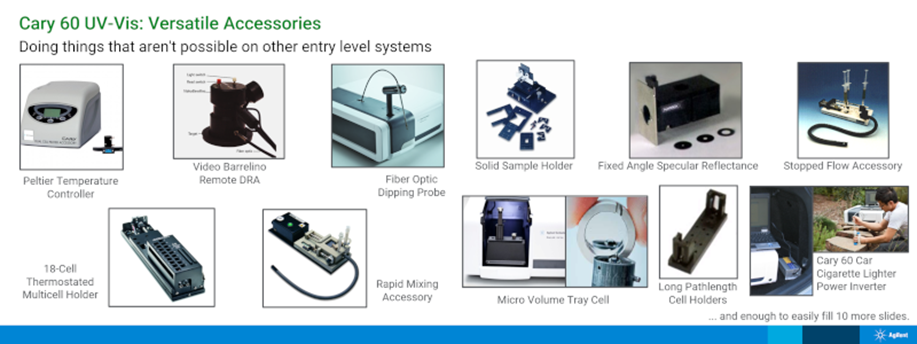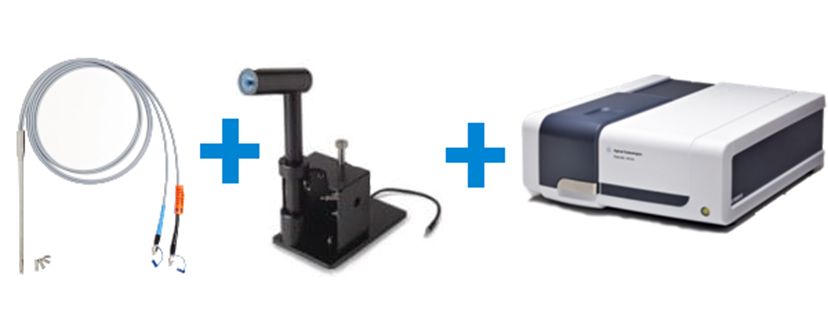
The Cary 60 UV-Vis and its nearly endless supply of accessories
We’ve written before about the many accolades of the powerful yet accessible Cary 60 UV-Vis and its highly flexible software. This instrument’s popularity seemingly knows no bounds and judging by the myriad of accessories available to handle all types of unique experiments, also shows no sign of slowing down either. The fiber optic dipping probe is one of the more common accessories seen in customer laboratories, and it’s obvious why this might be the case; doing away with pipetting samples into cuvettes entirely is an enticing proposition. Fiber optic capabilities aren’t normally seen within the entry level UV-Vis market due to their high spectroscopic performance requirements, however the Cary 60 UV-Vis’ photometric prowess is more than capable of handling such accessories.

Dip and click: the Cary 60 UV-Vis Fiber Optic Dipping Probe analyses liquids fast!
Depending on the circumstances, transferring samples from flasks to cuvettes can be one of the major efficiency bottlenecks of most UV-Vis experiments. It’s also generally cumbersome work. The Cary 60 UV-Vis Fiber Optic Dipping Probe does away with this bottleneck entirely. With this dipping probe, users can take direct measurements of liquid samples with the click of a button. This probe is attached to a fiber optic coupler which sits in the sample compartment of the Cary 60 UV-Vis.

The coupler captures all the light from the Cary 60 UV-Vis and focuses it onto a small fiber optic which extends into the probe. When the probe is submersed in a sample, liquid fills an exposed cavity where light can interact with the sample. This light is then returned back to the Cary 60 UV-Vis’ detector for analysis. The user needs only submerge the probe into a sample, click the button at the top, and a measurement is made automatically. All of this is only possible due to the Cary 60 UV-Vis’ superior optical performance and room light immunity, both key requirements for use of fiber optics.
The various shapes and sizes of the Cary 60 UV-Vis Fiber Optic Dipping Probe
Customers are always finding unique ways to use Cary 60 UV-Vis accessories, and the Fiber Optic Dipping Probe is no different. Heavy use across various fields and industries necessitates probes of several sizes and materials to accommodate a variety of experimental designs. Probes with several cavity sizes can be ordered to simulate cuvette pathlengths, as well as probes of different thicknesses to accommodate various container types (even small containers such as Eppendorf tubes). For aggressive solutions where samples are immersed in corrosive solvents, or for solutions at high temperatures, quartz and Torlon probes are available with very high resistance to heat and corrosion. Swapping between different probes requires no realignment, as such customers will often order a range of probes to cover all possible experimental encounters.
A standalone Fiber Optic Sampling Probe with a 3-meter fiber optic cable is also available. This handheld sampling probe is identical in features to the Dipping Probe, coming in all the same sizes and varieties. It is primarily designed for inserting into large sample vats, or other scenarios where the sample cannot easily be brought to the instrument and handheld control of the probe is preferred.

Head-to-head: cuvettes vs. Cary 60 UV-Vis Fiber Optic Dipping Probe
The time-saving benefits of using the Fiber Optic Dipping Probe over traditional cuvettes are quite significant. The video below illustrates how much faster and easier measurements are made using the Fiber Optic Dipping Probe compared to pre-filled cuvettes, with the probe carrying out the same experiment nearly twice as fast.
Many customers inquire about cleaning the probe between measurements. As shown in the above video, simply rinsing the probe for a few seconds with solvent between measurements is sufficient to minimize any carryover.
So why not use the Cary 60 UV-Vis Fiber Optic Dipping Probe everywhere?
While the Fiber Optic Dipping probe is certainly a very attractive accessory, there are a few instances where it may not be the best one for the job. Fiber optics by their very nature will reduce light throughput of any optical system, so if analysing highly absorbing media (e.g., over 2-3 absorbance units), or samples of very low concentrations, spectra obtained through the Fiber Optic Dipping Probe may not be suitable. In addition, some regulatory environments may not support the use of fiber optic sampling systems, depending on the application. When in doubt, feel free to contact us and we’ll do our best to assist!
Further reading
- Application note: Measuring the purity of low volumes of DNA at 4 °C using the Agilent Cary 60 UV-Vis spectrophotometer with fiber optics microprobe
- Application note: Nitrate Analysis of Water Using a Fiber Optics Dip Probe
- Application note: The determination of drug tablet concentration in pharmaceutical applications for drug development using the Agilent Cary 60 UV-Vis with fiber optics
- Webinar (recording): The Art of Remote Sampling Using a Cary 60 and Fiber Optics
Molecular spectroscopy webinar series
Get the latest product information and lots of helpful tips and tricks from our frequent molecular spectroscopy webinars. These live and interactive sessions take place every week, with all previous sessions available to watch on-demand.
- Got a question? Leave a note on the comments below or send your query directly to our expert spectroscopy team.
